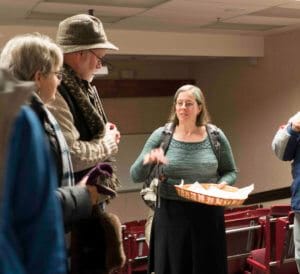Community members learn about life and the future of humanity
On Friday Jan. 26, about 30 members of the Sackville community came to terms with the fact that, according to science, humanity is doomed.
Starry Sackville is a free public lecture and observatory viewing organized by Mount Allison’s physics department that covers current astronomy-related topics twice a semester. At the Mini Wu, Friday’s talk tackled the topic of habitable zones and life on Earth.

To begin the lecture, astronomy professor Catherine Lovekin outlined the requirements for sustained life: “Elements are pretty prevalent throughout the universe, so we don’t have to worry about that too much.… There’s lots of different sources of energy depending on where you are. The real question then is water.”
Lovekin explained that, although Venus and Mars are relatively close to the Earth, the two planets are currently outside the habitable zone, as they do not have liquid water. According to Lovekin, at some point in the next two billion years, Earth too will move out the habitable zone and lose all of its water. Luckily, by the time this happens, Mars will have moved into the habitable zone, at which point humanity can move to Mars. However, the Sun will only be around for another seven billion years or so. After that, people will have to relocate to a new star. Eventually, the galaxy will run out of stars, meaning humanity will have to travel to another galaxy. Unfortunately, Lovekin explained that this may not be possible, as the universe is expanding at an accelerating rate.
Lovekin ended the presentation on an unsettling note: “Eventually, we’re going to be left in a galaxy that does not have any gas left to form stars. All the existing stars will die, the universe will become a dark, boring and fairly uniform place. There will be no source of energy, there will be no source of light.” Lovekin also offered her take on the future of humanity: “Unless we can all figure out how to become energy beings by then, everything is awful and we’re all going to die.”

Julia Connolly, a first-year psychology student, said, “I feel a little overwhelmed about how insignificant we really are in the grand scheme of things. It doesn’t make me feel scared or hopeless, it just makes me feel amazed at the world and the universe.”
Starry Sackville also draws in people from outside the Mt. A community. Emma Chisholm, a 14-year-old from Truro, is interested in astronomy, so her science teacher recommended the event to her. Chisholm is an optimist about the future of humanity. She said, “I think that it’s kind of scary, but I also think that science can get us there, so I think there’s hope. Especially about Mars.… I think scientists could get us there in the future.”
After Lovekin’s lecture, some of the attendees crossed the street to the Gemini Observatory. Here, Lovekin guided people toward the moon, Uranus and the Orion Nebula. The night finished at the observatory around 9:30 p.m.
The next Starry Sackville is tentatively scheduled for March 16 and the topic is yet to be determined.





